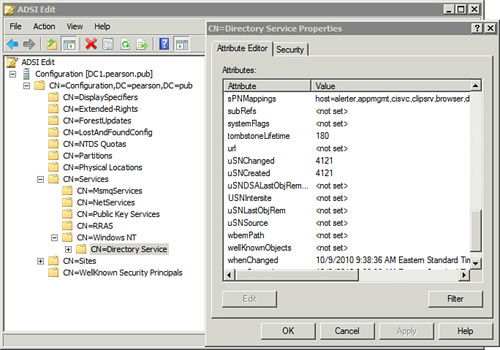You can use the following script to set the
tombstone lifetime. This script sets the tombstone lifetime to 365, but
you can change the number 365 in the script to any number desired.
Note
The tombstone lifetime identifies the maximum age of
a deleted object before it is permanently deleted. Tombstoned objects
can be authoritatively restored. However, once the tombstone lifetime
expires, they can no longer be restored.
set objdom = getobject("LDAP://rootdse")
set objds = getobject("LDAP://cn=directory service,cn=windows nt,"
& "cn=Services," & objdom.get("configurationnamingcontext") )
objds.put "tombstonelifetime",365
objds.setinfo
Note
Notice that the second line spans two lines but should only be entered as a single line.
The following table explains each of these lines.
| Creating an OU | Comments |
|---|
set objdom = getobject("LDAP://
rootdse")
| This line sets the context to the domain used by the computer using the rootdse shortcut. You can use this instead of naming the domain. The benefit is that the script is portable to any domain.
Note
LDAP must be all uppercase.
|
set objds = getobject("LDAP://
cn=directory service,cn=windows
nt," & "cn=Services," &
objdom.get
("configurationnamingcontext") )
| This command uses the getobject method to connect to the directory services container. Figure 1 shows the directory services container in the adsiedit tool. |
| objds.put "tombstonelifetime",365 | You can assign values to properties with the put method. This line sets the value of the tombstone lifetime property to 365. Figure 1 shows the current value as 180. |
| objou.setinfo | The setinfo method makes the change. |

You can use the following steps to view the ADSI Edit tool on a domain controller.
| Step | Comments |
|---|
| 1. | Click Start, type ADSI Edit, and double-click ADSI Edit in the Programs list. |
| 2. | Right-click ADSI Edit and select Connect to. |
| 3. | In the Connection Point section, Ensure that Select a Well Known Naming Context is selected. Select Configuration from the drop down menu. Click OK. |
| 4. | Select Configuration and expand it by clicking the plus (+). |
| 5. | Select CN=Configuration and expand it. |
| 6. | Select CN=Services and expand it. |
| 7. | Select CN=Windows NT and expand it. |
| 8. | Select CN=Directory Service. Right-click CN=Directory Service and select Properties. |
| 9. | Scroll down to Tombstone Lifetime to view the value.
Note
You can double-click it to set the value from here.
|